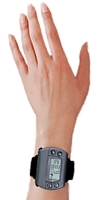*UPDATE* – Animas has decided that they will no longer be selling the GlucoWatch G2 Biographer system, as of July 31, 2007. They will continue to sell AutoSensors and provide customer support for this system until July 31, 2008.
In late March, insulin pump manufacturer Animas Corp. (West Chester, PA) completed its purchase of Cygnus Inc. (Redwood City, CA), maker of the only completely noninvasive glucose monitor, the GlucoWatch Biographer, approved by the FDA. Animas paid $10 million in cash for the intellectual property rights, production equipment, license agreements, and inventory belonging to Cygnus. Find out more about the deal here.

Cygnus received final FDA approval for their transdermal glucose sensor for adults 18 years and older in March 2001. They spent over 10 years developing this device that measures glucose through the skin using an AutoSensor, a replaceable pad that clips into the back of the GlucoWatch. The AutoSensor uses an adhesive to stick to the skin to allow it to come in contact with a small electrical charge that begins a process called reverse iontopharesis. This electrical charge brings glucose to the skin surface where an enzyme reaction, similar to that found in a standard meter, generates electrons from which glucose levels can be closely estimated. The AutoSensors are manufactured in conjunction with Dupont on a Polymer thick film.
The GlucoWatch measures glucose every 10 minutes (3 minutes of electrical stimulation, then 7 minutes of glucose measurement) and then these two measurements are averaged. If sweating occurs or there is any significant inconsistency between the two readings, a “skipped reading” will be seen on the device, rather than a glucose reading. On average, Cygnus reports that users get an average of 26 out the 36 possible readings during 12 hours of testing, so users should not be alarmed by the frequency of skipped readings. A significant 21% of users will get fewer than 12 readings per use. Loss of readings can also occur with rapid temperature changes, cold skin, bumping and excess movement.
Alerts can be personalized for high and low blood sugars, and for “most” or “all” events. An alarm occurs when a rapid change is seen in the blood sugar (more than a 35% change from any reading in the last hour), when you perspire (one sign of a low), and for any readings above or below your target levels. A trend indicator appears to show the direction of the blood sugar when the current reading is more than 18 md/dl (1 mmol) higher or lower than the last reading.
The Biographer is very helpful at showing patterns and trends in your blood sugars, detecting after meal spiking, stopping nighttime low blood sugars, and sorting out the causes for morning highs. It is not, however, a true continuous monitor. Due to the three to three and a half hour warm up period, only half of each day can realistically be monitored. Most users are expected to use the device intermittently rather than continuously. The user cannot shower, bathe, or swim during the warm-up period, although users have found Saran wrap or a plastic bag to be helpful here.
A standard blood sugar meter is used to calibrate the GlucoWatch, so that a less-than-precise measuring device is calibrated using a less-than-precise meter, essentially doubling the inaccuracy. The most important step for accuracy is to ensure that an accurate blood sugar test is done for entry into the Biographer, and also that your blood sugar not be rising or dropping rapidly during this time.
Event markers can be recorded for activities like meals, insulin, and exercise. Cygnus tested 1,400 devices to get FDA approval with 19,000 data points over 25,000 hours of use. Other studies showed a correlation coefficient of 88% compared to meters which get above 90%. See the FDA Press Release.
Even with this accuracy, one of every 4 readings will vary by more than 30% from the actual blood sugar, so accuracy should never be assumed from the watch itself. The FDA recommends that single GlucoWatch readings never be used to change therapy and that readings be checked first with a standard meter. The 20 minute testing frequency and the ability to watch for trends in glucose readings helps to offset these occasional less accurate readings.
Most users report the electrical discharge to be quite noticeable during the first use of the device, but less noticeable on subsequent uses. Skin irritation limits reuse of the same site for several days to a week or two, so “watch” does not mean the Biographer can be worn in the same place on the wrist like a wristwatch. Rotating sites is important for preventing significant skin irritation for about 80% of users. Another 10% will discover they have little irritation, and about 10% may find skin irritation and itching prevents use of the device. Users report that washing the skin immediately after removing the AutoSensor, use of a skin lotion, or application of a small amount of 1% hydrocortisone cream reduces skin problems.
The new found frequency of blood sugar readings from the Biographer does require patience from users, as they learn how and when to respond to the many additional high and low readings they are faced with.
As noted, sweating and skipped readings are problematic (See also our report on the Sleep Sentry.). When sweat glands open up due to heat, hypoglycemia or exercise, this device is unable to measure glucose. All in all, as the first device of its kind, the GlucoWatch is expected to be in high demand despite these problems. The Biographer is best suited for the patient, dermis-neutral, and technologically adept individual.
